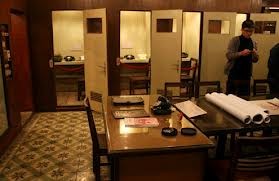(VOVworld) - Located in the Thang Long Ancient Citadel, the underground commander’s combat of the General Staff played an important role in the American war, especially the 12 days and nights of the Hanoi-Dien Bien Phu in the air battle 40 years ago. The underground has been reopened for people to visit. Our reporter Hong Van will take you there to find out more about the secrets behind the underground through memories of Lieutenant General Nguyen Van Ninh and his comrades.
 |
Leading groups of people who are visiting the underground on the first days it is opened to the public, Lieutenant General Nguyen Van Ninh is eagerly introducing the place where he used to work as Deputy Head of the commander’s combat in the 1970s. During the 12 days and nights of the Dien Bien Phu in the air battle, the small underground tunnel served as a command center which received and interpreted military intelligence on the movements of B-52 sorties, observed the strategic situation throughout Indochina, issued combat orders from the General Staff. General Ninh recalled the tense atmosphere on the first day of the US air attack on Hanoi: "On December 18th, the first day of the campaign, at 4 p.m, we received some information. Then Deputy Chief of the General Staff Phung The Tai said diplomat Le Duc Tho had returned and said the US had stopped the Paris negotiation. At 6.20 p.m, there was a B-52 alert. We assumed that the US was going to bomb Hanoi. At 7 p.m, I reported to Chief of the General Staff Van Tien Dung and asked for an early warning, 25 minutes before the bombardment. This had never happened before in the world".
General Ninh said the B-52 alert came directly from this underground bunker: "This is the button for the electric alarm on the roof of the National Assembly building in Ba Dinh square. If the Ba Dinh alarm rang, 15 other electric alarms in Hanoi were set off. I was the one who pressed the first B-52 alarm for Hanoi, alerting the armed forces and warning civilians to go to a bomb shelter".
Staff remained on duty around the clock in the underground bunker for 12 days and nights. Pham Thi Thanh, a staff member, spent days and nights in the bunker monitoring the air routes of the US aircraft: "We had to wear headphones at all times during our shifts. Whenever we received a signal from our air defence force, we had to find it on the map. If the aircraft approached within 50 kilometers of Hanoi, the commanding officer would check the maps and give the alarm order".
Vu Thi Thu Ha, another staff member explains her work in the bunker 40 years ago: "We had to observe the bombed areas and report to the leaders. We served as guides for the commanders to issue alarm orders for Hanoi. There would be grave consequences if we made even a minor mistake".
The second floor of the Combat Operations Department was reduced to rubble to disguise the underground bunker. The bunker was specially designed by Colonel Nguyen Quan Hong. It covered an area of 64 square meters and was equipped with an air filter system, cooling, ventilation, and electrical power: "The bunker was made of monolithic concrete. There were 3 layers on the roof. The top and the base were made of concrete and the middle layer was sand, giving extra protection from the bombs to the people inside. The door had 2 thick layers capable of withstanding bombs and rockets".
Many objects used by General Ninh and his comrades during the war such as telephones, maps, trays and tea sets are now on display in the underground bunker.